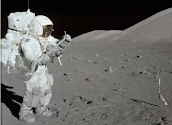How do you clean a space suit?
NASA is planning another crewed flight to the Moon after 51 years. Yes, it was 1972 that the last humans set foot on the lunar surface. The Artemis Program is in full swing to build an orbiting structure called Gateway as well as a surface facility called the Artemis Base Camp. A lot has changed since 1972, but an old problem that will need to be solved is still being worked on. That is how to remove moon dust from space suits.
Astronauts have a jumpsuit they wear inside the capsule, space station, or space shuttle to perform normal functions. The space suit worn outside the spacecraft faces environmental conditions significantly harsher. Suits must protect the wearer from temperature extremes, lack of air, radiation, sunlight, and injury, as well as provide the most mobility and visibility possible, ways to carry tools and operate them most efficiently. They also need to remain as white as possible to reflect sunlight and to allow others to see the astronaut, whether in space or on the Moon.
Besides the need for such suits to be durable, tough, insulating, and properly protective, astronauts who have worked on the Moon encountered a "sticky" problem that needed to be overcome. Moon dust. Collecting rock samples, walking on the lunar surface, and riding in the lunar rover all generated small particles of moon dust that were difficult to remove from the suits, electronic equipment, solar panels, and lenses. They also made tools and ladders slippery. Clogging and potentially damaging materials are obvious problems, but since the dust holds an electrical charge, some people are concerned that it may also interfere with electronics and even pose a sparking hazard.
These particles are 50 micrometers or smaller in diameter (about 0.00078 inches), smaller than flour particles and more like ash. In comparison, the average human is 16-50 micrometers thick. Lunar material is composed of the following:
- 50% SiO2
- 15% Al2O3
- 10% CaO
- 10% MgO
- 5% TiO2
- 5-15% iron
- traces of sodium, potassium, chromium, and zirconium
Solar radiation bombarding the Moon's surface creates a negative electrical charge on lunar dust. That's what makes it stick to surfaces. The lack of moisture or erosion on the Moon makes it extremely powdery. Because of the fine particle size and their electrostatic charge, moon dust clings to everything. Astronauts can't help but bring it inside their spacecraft, where it floats around and clogs equipment, as well as causing radiators to overheat. It also blocks the seals on the space suits where helmets and gloves attach, and in some suit designs, where the bottom section joins with the upper torso.
What's more, it gets into the eyes, nose, and lungs. Astronaut Harrison Schmitt experienced the first case of "lunar hay fever" aboard Apollo 17 when he inhaled the dust after removing his helmet. A flight surgeon examining suits after that flight also suffered the same congestion.
In 1966, Professor Brian O'Brien from the University of Western Australia developed a moon dust detector the size of a match box for Apollo 11 (and later missions). When dust covered its solar cells, there was a decrease in voltage, and that data was beamed back to Earth every minute. To date, these are the only data we have on moon dust accumulation on the surface.
Moon dust may be powdery but it isn't smooth like rocks on Earth. Instead, the particles are as sharp as glass and can severely damage skin, eyes, and lungs and even cut space suits.








No comments:
Post a Comment